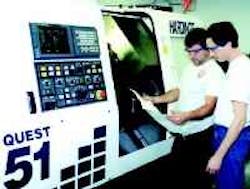Multitasking lathe means hands-off machining
Amherst Machine Owner Jim Bernotas (right) and technician Jaroslav Roth examine a drawing before the shop's Hardinge Quest 8/51 lathe, which reduces floor-to-floor time for one complex part by 49%.
This flange once required 26 steps and five manual setups on two different machines. Amherst Machine now uses a Quest 8/51 lathe to make the part from barstock without operator handling.
Machining a 5 /8-in. 2 aluminum flange took Amherst Machine Co. in Amherst, Ma., only 4.5 min, but it required 26 steps and five manual setups on two different machines. All this handling time practically equaled part machining time, so the company needed a machine that could do all the operations with less part handling. That machine was a Hardinge Quest 8/51 lathe.
The fully automated, multitasking lathe trimmed machining time down to 3 min. But, more impressively, it eliminated manual transfer, hand setups, and the need for a second machine — all of which slashed overall cycle time for the flanges by 49%.
Starting with 1-in. barstock, the 7-axis Quest 8/51 initially turns O.D.s and bores one I.D. It then faces and turns another O.D., bores two more I.D.s, and mills four flat surfaces on one O.D. For two of these flat surfaces, live tooling drills 0.080-in.-diameter holes through to the center of the part. After which, the machine drills and counterbores four holes in the flange face and cuts the part off, leaving it in the subspindle.
On the retained workpiece, the lathe faces and turns another diameter. It then countersinks the four holes in the flange face and ejects the finished part, which is within a 0.0002-in. tolerance, into a parts catcher.
"Prior to the Quest 8/51," says Jim Bernotas, owner of Amherst Machine, "we used a 2-axis turning machine and a 3-axis milling machine. On the turning machine alone, part features required operators to handle parts twice. And after turning, batches of parts were manually transferred to the milling machine for milling, drilling, and tapping with more manual steps."
The Quest 8/51 lathe, with an 8-in. chuck, 2-in. bar capacity, and 20-hp main spindle, provides power and room for turning Amherst parts. It accommodates workpieces more than 12 in. in diameter and has 20 in. of swing over its way covers. But most important are the machine's multitasking options that reduce cycle times and part handling at Amherst.
The shop's Quest 8/51 has a 4,200-rpm main spindle and 6,000-rpm sub-spindle. Both are compatible with different collets for conventional chucking, through-bar, or the machine drills and counterbores four holes in the flange face and cuts the part off, leaving it in the subspindle.
On the retained workpiece, the lathe faces and turns another diameter. It then countersinks the four holes in the flange face and ejects the finished part, which is within a 0.0002-in. tolerance, into a parts catcher.
"Prior to the Quest 8/51," says Jim Bernotas, owner of Amherst Machine, "we used a 2-axis turning machine and a 3-axis milling machine. On the turning machine alone, part features required operators to handle parts twice. And after turning, batches of parts were manually transferred to the milling machine for milling, drilling, and tapping with more manual steps."
The Quest 8/51 lathe, with an 8-in. chuck, 2-in. bar capacity, and 20-hp main spindle, provides power and room for turning Amherst parts. It accommodates workpieces more than 12 in. in diameter and has 20 in. of swing over its way covers. But most important are the machine's multitasking options that reduce cycle times and part handling at Amherst.
The shop's Quest 8/51 has a 4,200-rpm main spindle and 6,000-rpm sub-spindle. Both are compatible with different collets for conventional chucking, through-bar, or secondary operations. The synchronized spindles facilitate part transfer for secondary machining without lost time or misalignment. In addition, both spindles provide C-axis motion in 0.001° increments. This provides for 3D contouring and complex round and prismatic machining along with the ability to tackle square-shoulder machining.
Its Y-axis motion mills threads and performs other complex off-center milling and drilling operations. With 12 live tooling stations, the lathe does cross or end-milling and drilling operations on parts in either spindle. These adjustable live toolholders also let Amherst mill and drill on angles.
In addition, fast machine movement plays a large part in the reduction of Amherst's non-cutting times. With a 1,500-ipm traverse in the Z axis and 1,100 ipm in the X, the Quest 8/51 is twice as fast as the shop's other lathe.
This speed shortens Amherst's production time for small batches of parts that cost no more than $12 each, says Bernotas. "We can now do tight-tolerance, multi-operation parts that really can't be economically produced any other way," he adds.
Hardinge Inc.
Elmira, N.Y.
www.hardinge.com
